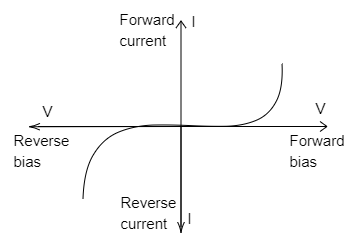
When does an Avalanche breakdown happen in a diode?
(A) the potential barrier is reduced to zero.
(B) the forward current exceeds a certain value.
(C) reverse bias exceeds a certain value.
(D) none of these.
Answer
515.6k+ views
Hint: Breakdown happens when the electric field enhances strongly enough so that it can pull electrons from the molecules of a material and ionizes them. The free electrons are increased in speed by the field which strike other atoms which results in creating more free electrons.
Complete answer:
Break down of a diode usually occurs in the reverse biased state. Under the reverse biased state of a PN diode, the positive end of the battery is connected to the n-side of the diode and the negative end is connected to the p-side of the diode. As an outcome of this, electrons will be drawn in respect to the off-side and the holes will be drawn in respect to the side of the p-side. There are two types of breakdown that happen in a diode. They are Zener breakdown and Avalanche breakdown.

Zener diode:
The phenomena of Zener breakdown that happens in a pn junction diode of heavy doping and a thin junction, that is in a way that the size of the depletion layer is very small. Zener breakdown is not that the diode is damaged. As the current is only because of drifting of electrons, there are certain limitations to the increase in current.
Avalanche breakdown:
The phenomenon of Avalanche breaks down that happens in a pn junction diode which is averagely doped that has the thickest junction, that is the thickness of the depletion section is high. This phenomenon normally takes place when there is a greater reverse voltage. Which is evidently greater than that of the Zener breakdown voltage. That is when we increase the applied reverse voltage, the electric field over the junction will keep on rising.
Therefore, Avalanche breakdown in a diode occurs when the reverse bias exceeds a certain value.
Hence, the option (C), reverse bias exceeds certain value is the correct.
Note: In a Zener the current that is essential to split the electrons from the covalent bonds can be obtained with the help of lower voltage than that of the avalanche, which is due to the thin layer of the pn junction. Since the thickness of the depletion in the avalanche is higher than that of the Zener the required electrons to split the covalent bond is greater.
Complete answer:
Break down of a diode usually occurs in the reverse biased state. Under the reverse biased state of a PN diode, the positive end of the battery is connected to the n-side of the diode and the negative end is connected to the p-side of the diode. As an outcome of this, electrons will be drawn in respect to the off-side and the holes will be drawn in respect to the side of the p-side. There are two types of breakdown that happen in a diode. They are Zener breakdown and Avalanche breakdown.

Zener diode:
The phenomena of Zener breakdown that happens in a pn junction diode of heavy doping and a thin junction, that is in a way that the size of the depletion layer is very small. Zener breakdown is not that the diode is damaged. As the current is only because of drifting of electrons, there are certain limitations to the increase in current.
Avalanche breakdown:
The phenomenon of Avalanche breaks down that happens in a pn junction diode which is averagely doped that has the thickest junction, that is the thickness of the depletion section is high. This phenomenon normally takes place when there is a greater reverse voltage. Which is evidently greater than that of the Zener breakdown voltage. That is when we increase the applied reverse voltage, the electric field over the junction will keep on rising.
Therefore, Avalanche breakdown in a diode occurs when the reverse bias exceeds a certain value.
Hence, the option (C), reverse bias exceeds certain value is the correct.
Note: In a Zener the current that is essential to split the electrons from the covalent bonds can be obtained with the help of lower voltage than that of the avalanche, which is due to the thin layer of the pn junction. Since the thickness of the depletion in the avalanche is higher than that of the Zener the required electrons to split the covalent bond is greater.
Recently Updated Pages
Mass vs Weight: Key Differences Explained for Students

Young’s Double Slit Experiment Derivation Explained

Electricity and Magnetism Explained: Key Concepts & Applications

JEE Energetics Important Concepts and Tips for Exam Preparation

JEE Isolation, Preparation and Properties of Non-metals Important Concepts and Tips for Exam Preparation

JEE Main 2021 July 25 Shift 1 Question Paper with Answer Key

Trending doubts
JEE Main 2026: Application Form Open, Exam Dates, Syllabus, Eligibility & Question Papers

Understanding Uniform Acceleration in Physics

Derivation of Equation of Trajectory Explained for Students

Hybridisation in Chemistry – Concept, Types & Applications

Understanding the Angle of Deviation in a Prism

How to Convert a Galvanometer into an Ammeter or Voltmeter

Other Pages
JEE Advanced Marks vs Ranks 2025: Understanding Category-wise Qualifying Marks and Previous Year Cut-offs

Dual Nature of Radiation and Matter Class 12 Physics Chapter 11 CBSE Notes - 2025-26

Understanding Centrifugal Force in Physics

JEE Main Marking Scheme 2026- Paper-Wise Marks Distribution and Negative Marking Details

Degree of Dissociation: Meaning, Formula, Calculation & Uses

Ideal and Non-Ideal Solutions Explained for Class 12 Chemistry




